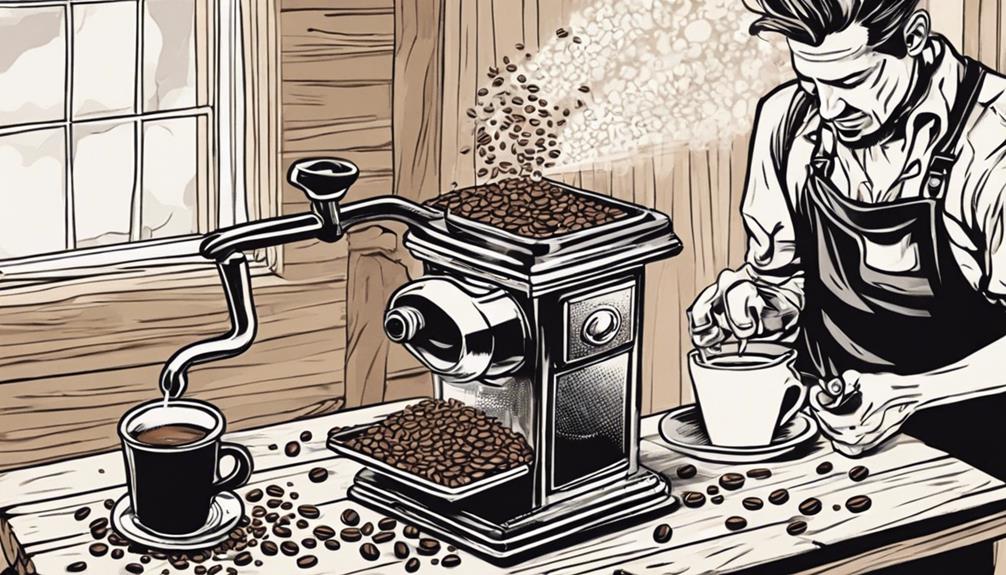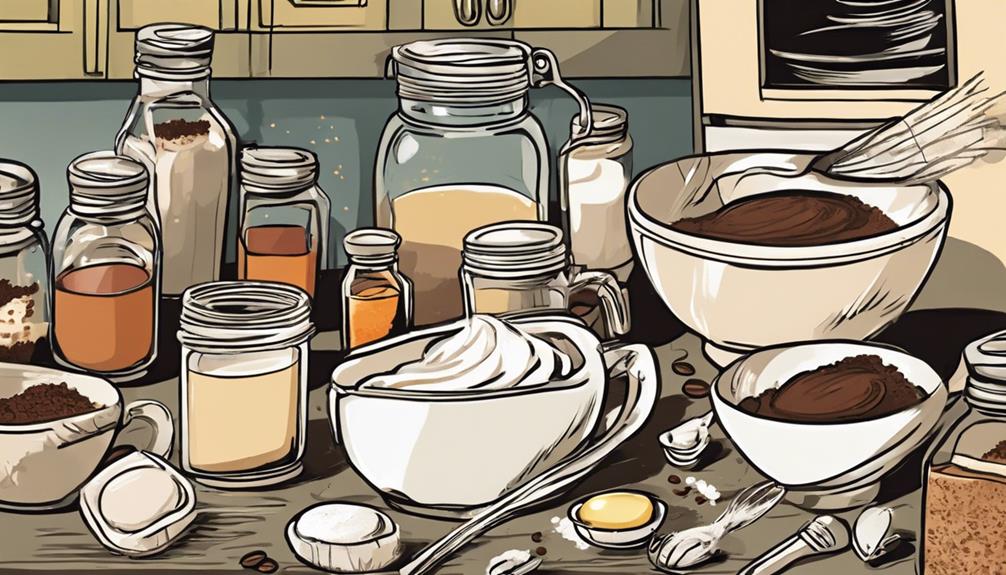Light dry, used coffee grounds similar to incense for efficient mosquito control. Position the burning grounds in the direction of the wind to naturally repel bugs. Increase the burning process by placing a moist towel over the grounds. The smoky aroma serves as a barrier to insects without the use of chemicals. Find a safe and environmentally friendly method to ward off pests outdoors.
Key Takeaways
- Burn dry, used coffee grounds like incense for a smoky mosquito deterrent.
- Position smoldering grounds upwind to repel insects effectively.
- Cover smoldering coffee grounds with a damp towel for enhanced mosquito control.
- Create a natural barrier with burnt coffee grounds to keep bugs away.
- Use this chemical-free method for eco-friendly pest control outdoors.
Coffee Grounds Repel Mosquitoes
Burn coffee grounds to effectively repel mosquitoes with their strong scent that mosquitoes find unpleasant. When burning coffee, the aroma acts as a natural deterrent for these pesky insects, keeping them at bay.
Utilizing used coffee grounds and burning them strategically can create a barrier to discourage mosquitoes from entering specific areas around your home. The smoldering effect of burning coffee grounds releases a potent smell that interferes with mosquitoes' ability to locate human targets, making it an effective method for mosquito control.
Additionally, dampening coffee grounds with water can also release a scent that repels mosquitoes effectively. By incorporating burned coffee grounds into your mosquito control strategy, you can enjoy outdoor activities without the nuisance of these buzzing pests.
Give this natural repellent a try and experience a mosquito-free environment using something as simple as your morning coffee grounds.
Types of Coffee Grounds for Control

To effectively utilize coffee grounds for mosquito control, it's vital to understand the types of coffee grounds that work best for repelling these insects. Unflavored coffee grounds, whether fresh, used, or burnt, are all suitable for this purpose.
When burning coffee grounds, the aroma intensifies, enhancing their efficacy as a repellent. To further boost their mosquito-repelling properties, consider toasting the grounds in a skillet to amplify the fragrance. It's important to avoid using flavored coffee beans for this method and make sure that the grounds are in the desired form before application.
Coffee shops often provide used grounds for free, making them a convenient and eco-friendly option for mosquito control. By utilizing these types of coffee grounds effectively, you can create a natural and potent repellent to keep mosquitoes at bay.
Whether using fresh, used, or burnt coffee grounds, they all serve as effective tools in your fight against these pesky insects.
Using Coffee Grounds as Repellent

When utilizing coffee grounds as a repellent, you can rely on their strong scent to effectively deter mosquitoes and other insects. The potent aroma of coffee grounds acts as a natural barrier, keeping mosquitoes at bay while also deterring pests like wasps and bees from invading your outdoor space.
Burning coffee grounds releases a smoldering smoke that signals danger to bugs, effectively controlling their presence around your home. This method of using coffee grounds as a natural repellent isn't only safe but also eco-friendly, offering a chemical-free pest control solution for your environment.
Burning Coffee Grounds Technique

To effectively repel mosquitoes using the burning coffee grounds technique, start by igniting dry, used coffee grounds like incense.
Place the smoldering coffee grounds in an upwind location to create a smoke barrier that deters bugs naturally.
Covering the burning coffee grounds with a damp towel can enhance the smoldering effect, providing maximum pest control.
Smoke for Pest Control
Consider employing the burning coffee grounds technique as a natural way to repel mosquitoes and other pests with smoldering smoke. Burning coffee grounds releases smoke that acts as a deterrent to insects by signaling danger, effectively keeping them away from your outdoor area.
To enhance this repellent effect, place burnt coffee grounds in a heat-resistant container, add a few drops of lighter fluid, and ignite them. Best dispersion of the smoldering smoke can be achieved by choosing an upwind location for burning the coffee grounds.
For sustained mosquito control, cover the burning coffee grounds with a damp towel to maintain a steady smoldering effect. This method provides a chemical-free way to combat pests and create a more comfortable outdoor environment for you and your family.
Deter Bugs Naturally
Burn coffee grounds as a natural method to deter bugs, particularly mosquitoes, effectively with smoldering smoke. This DIY mosquito repellent technique isn't only eco-friendly but also a cost-effective way to keep pesky insects at bay. Here are some key points to ponder:
- Strong Scent: Burning coffee grounds releases a potent aroma that acts as a natural mosquito repellent.
- Smoke Signal: The smoldering smoke from burnt coffee grounds serves as a warning sign to bugs, deterring them from invading your outdoor space.
- Versatile Pest Control: Besides mosquitoes, coffee grounds can also repel wasps and bees, making it a versatile solution for insect control.
Applying Coffee Grounds to Plants
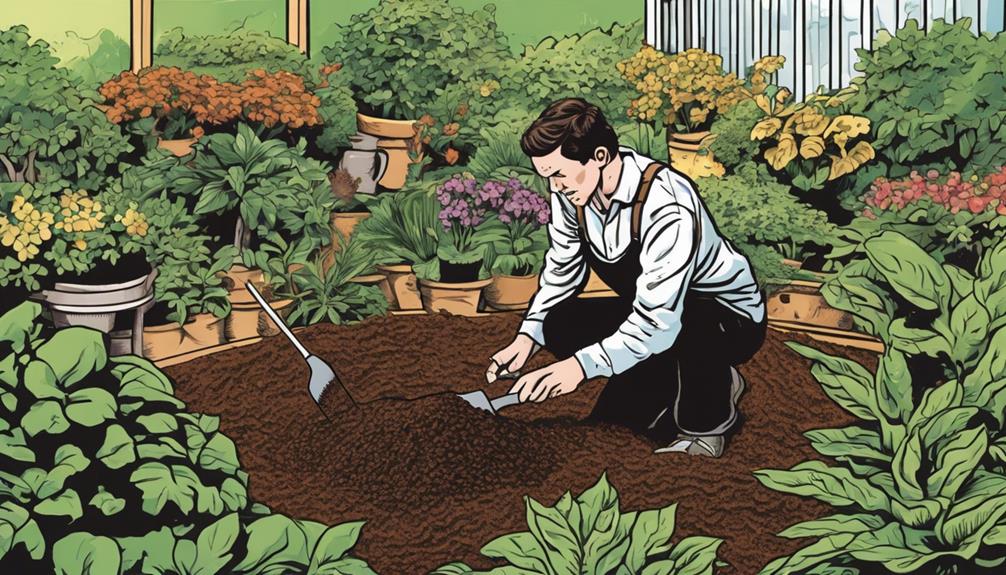
For deterring mosquitoes around your garden plants and trees, sprinkle aged coffee grounds as a natural and safe alternative to chemical repellents. Used coffee grounds can be a valuable resource in keeping your outdoor space mosquito-free. These grounds not only repel adult mosquitoes due to their strong scent but can also help target and eliminate mosquito larvae effectively, preventing future generations from hatching near your plants.
To apply coffee grounds to your plants and trees, simply sprinkle a thin layer around the base of the plants or on the soil surface. Remember not to overdo it, as too much coffee grounds can affect the pH of the soil. Here is a practical guide on how to use coffee grounds for mosquito control:
| Coffee Grounds Usage | Instructions |
|---|---|
| Around Plants | Sprinkle a thin layer near the base of plants. |
| In Standing Water | Add directly to standing water where mosquito larvae are present. |
Benefits of Coffee Grounds Repellent
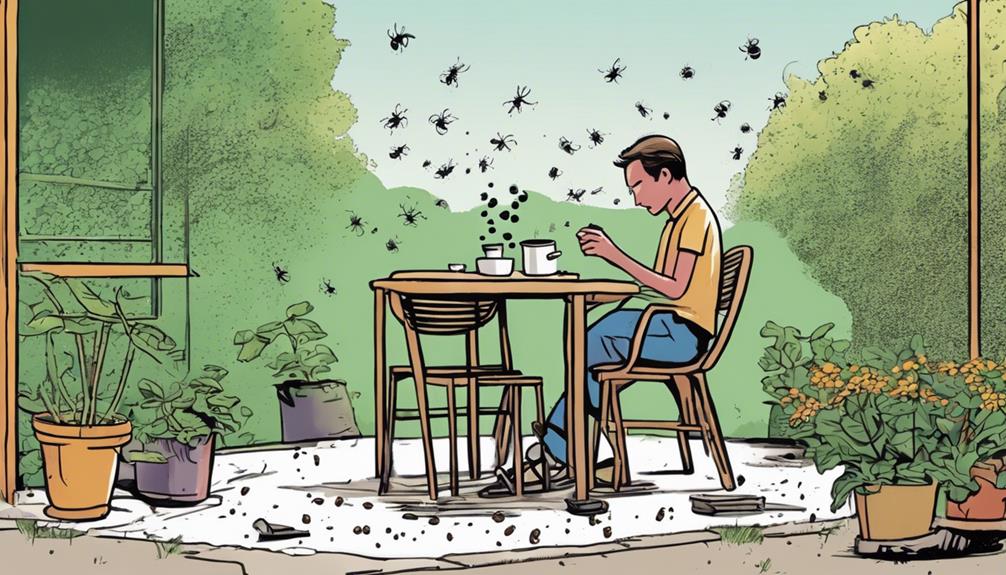
You'll be amazed at the aromatic mosquito-repelling qualities of burnt coffee grounds.
The smoky scent acts as a powerful deterrent not just for mosquitoes but also for other pesky insects like wasps and bees.
Embrace this natural method to keep pests at bay and create a safe, eco-friendly outdoor environment.
Aromatic Mosquito Deterrent
By using coffee grounds as a mosquito repellent, you can benefit from their aromatic properties that naturally deter insects. When burnt, coffee grounds release a powerful scent that keeps mosquitoes at bay, making them an effective and natural solution for pest control. Here are some benefits of using coffee grounds as an aromatic mosquito deterrent:
- Repels Mosquitoes: The strong aroma of burnt coffee grounds acts as a natural mosquito repellent, creating a bug-free environment.
- Deters Other Insects: In addition to mosquitoes, coffee grounds also discourage other insects like wasps and bees from invading outdoor spaces.
- Signals Danger: The smoldering smoke produced by burning coffee grounds sends a signal of danger to pests, further deterring them from the area.
Pest-Repelling Smoky Scent
Creating a pest-repelling smoky scent, burnt coffee grounds effectively deter mosquitoes and other insects from your outdoor spaces. When you burn coffee grounds, the strong aroma emitted acts as a natural barrier against pests like mosquitoes, wasps, and bees.
The smoky scent not only masks the scents that attract insects but also confuses and warns them of potential danger. This method offers a safe and eco-friendly approach to pest control without the use of harmful chemicals.
The smoldering smoke produced by burning coffee grounds serves as a signal to bugs to stay away from your living areas. By utilizing burnt coffee grounds, you not only repel mosquitoes but also contribute to a sustainable way of keeping unwanted bugs at bay in your outdoor environment.
Embrace the power of coffee grounds to create a protective smoky shield against pests and enjoy your time outdoors without the nuisance of insects.
Alternative Mosquito Repellents
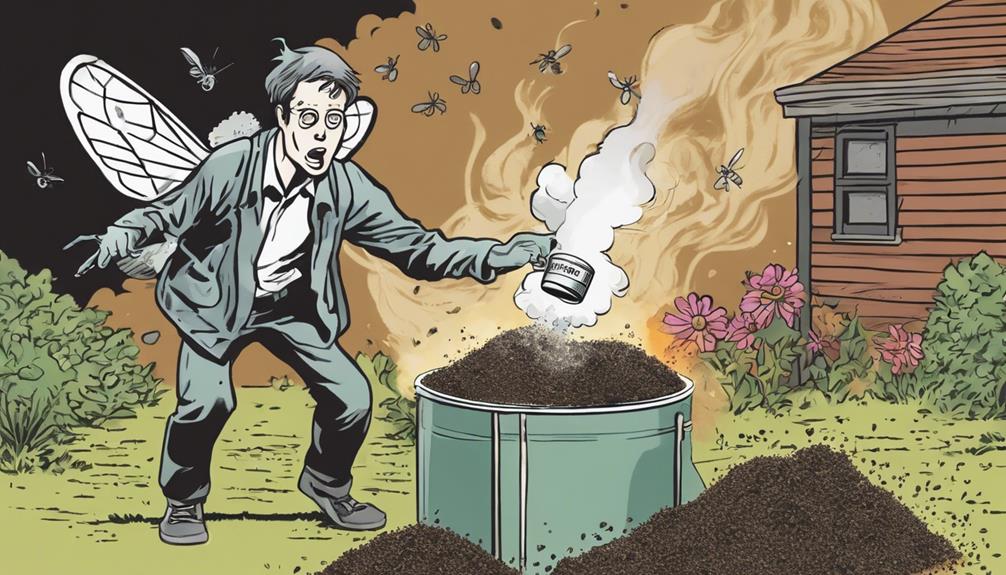
Consider using alternative mosquito repellents such as dryer sheets, citronella candles, egg packages, and homemade bug spray as effective methods to keep those pesky insects at bay.
- Dryer Sheets: Place a dryer sheet in your pocket or under a hat to help repel mosquitoes while outdoors.
- Citronella Candles: Light citronella candles in your outdoor spaces to create a barrier against mosquitoes.
- Egg Packages: Mosquitoes are deterred by the scent of eggshells, so placing egg packages around your yard can help keep them away.
In addition to these alternatives, burning coffee grounds is a natural and efficient way to ward off mosquitoes. Remember to use unused coffee grounds for the best results. Different types of coffee grounds may vary in effectiveness, so experimenting with brewing methods and quantities can help you find the most suitable option for your mosquito repellent needs.
Effectiveness and Adjustments

To maximize the effectiveness of coffee grounds as a mosquito repellent, adjust the quantity based on the level of mosquito activity in your surroundings. If you notice a high density of mosquitoes, consider using a larger amount of coffee grounds to enhance the repellent effect.
Remember, unused coffee grounds are recommended for the best mosquito control outcomes. Experiment with different brewing methods to boost the potency of the coffee grounds as a repellent. Some brewing methods might result in a stronger scent that could potentially improve the effectiveness against mosquitoes.
Additionally, take into account your personal scent preferences when using coffee grounds to repel bugs. What might be pleasant to you could also act as a deterrent for mosquitoes.
Miscellaneous Tips and Questions

For additional tips and answers to common questions about using coffee grounds as a mosquito repellent, explore the following insights and recommendations. Another helpful resource for using coffee grounds as a mosquito repellent is to check out online forums and discussion threads where people share their experiences and tips. You can also look for DIY tutorials on how to build a coffee table, which may include creative ways to incorporate coffee grounds into the design for added insect repellent benefits. Additionally, experimenting with different methods of using coffee grounds, such as creating a natural spray or incorporating them into candles, can provide further insight into their effectiveness as a mosquito repellent.
- Try Different Coffee Brands: Experiment with various brands like Folgers or Maxwell House to determine which works best for repelling mosquitoes.
- Be Cautious of Allergic Reactions: Avoid potential allergic reactions to chemical sprays by opting for natural repellents like burning coffee grounds.
- Adjust Brewing Methods: Tweak brewing methods and quantities based on the bug density in your area to enhance the effectiveness of coffee grounds as a repellent.
When burning coffee grounds for mosquito control, keep in mind the differences between ground coffee and used coffee grounds for best results. If you don't consume coffee, consider using specific brands like Tim Hortons for burning purposes.
Frequently Asked Questions
How Do You Burn Coffee Grounds to Repel Mosquitoes?
To burn coffee grounds and repel mosquitoes, gather dry used coffee grounds. Place them in a heat-resistant container, light them up, and let them smolder. Enhance the effect by dampening the grounds before burning for stronger repellent power. Remember to keep the burning coffee grounds away from anything flammable, and never leave them unattended. Additionally, ensure there is proper ventilation in the area where you are burning the grounds to avoid inhaling too much smoke. Following these burning coffee safety tips will help you effectively repel mosquitoes while minimizing the risk of accidents or health issues.
What Is the Best Thing to Burn to Keep Mosquitoes Away?
To keep mosquitoes away, the finest thing to burn is coffee grounds. Their strong scent deters pests effectively. Place burning grounds upwind for superior spread. It's a safe, natural way to repel mosquitoes outdoors.
How Do You Make Homemade Mosquito Repellent?
So, you want to make homemade mosquito repellent? Easy! Burn dry coffee grounds for a smoldering effect mosquitoes hate. The strong scent deters bugs, while the smoke signals danger, keeping your outdoor space bug-free.
What Insects Do Coffee Grounds Repel?
Coffee grounds repel insects like mosquitoes, wasps, and bees. Their strong scent deters pests from invading your outdoor spaces. Burning coffee grounds creates a smoldering effect that warns bugs away, serving as a natural barrier against various insects.
Conclusion
So next time you're looking for a natural way to repel those pesky mosquitoes, why not give burning coffee grounds a try?
Not only is it effective, but it's also a sustainable and eco-friendly option.
Say goodbye to chemical sprays and hello to a fragrant and effective mosquito control method.
Your outdoor space will thank you!




